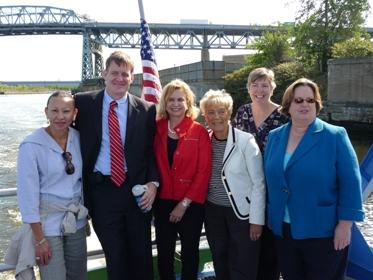Indifference to filth and pollution for over a century has mutated Newtown Creek into more of a beast than a beauty.
Beginning in the mid-1800s, contaminants were spewed into Newtown Creek by more than 50 refineries that called the waterway home, including sawmills, lumber and coal yards, fertilizer and glue factories, petrochemical plants and oil refineries. The creek was also used by commercial vessels to transport oil, chemicals, fuel and other raw materials. During World War II, the channel was one of the busiest ports in the nation, and factories continue to operate on its banks to this day.
Congressmembers Carolyn Maloney and Nydia Velázquez, Borough President Helen Marshall and Assemblymember Catherine Nolan joined EPA Regional Administrator Judith Enck on a boat tour of the Newtown Creek cleanup project on October 11. During the tour, the Queens leaders were taken to the key areas of pollution in the creek.
“For far too long, Newtown Creek has been a disgrace: a toxic dumping ground since the mid-1800s, a blight on our waterways, and the scene of perhaps the largest oil spill of all time – three times the size of the Exxon Valdez,” said Maloney, referencing the Greenpoint oil spill.
In addition to the damage done by industrial pollution, the city began dumping raw sewage into the water in 1856.
As a result of its history, which includes multiple spills, Newtown Creek is among the most polluted waterways in America.
In the early 1990s, New York State declared that the channel was not meeting water quality standards under the Clean Water Act, and since that time, several government-sponsored cleanups have occurred.
Newtown Creek, whose waters wash the shores of both Queens and Brooklyn, was designated a Superfund site by the Environmental Protection Agency (EPA) in September of last year.
The Superfund Program was established by Congress to locate, investigate and cleanup the most hazardous sites across the country. It also provides the EPA with the authority to coerce responsible parties to account for the damage they have done, either by cleaning up the site themselves or by reimbursing the government for all costs associated with the restoration.
This past July, following a year-long examination, the EPA entered into a consent order with six potentially responsible parties to conduct a remedial investigation and feasibility study of the creek’s cleanup. Field work for the investigation, which will determine the nature of the pollutants, evaluate any risks to human life or the environment and assess prospective cleanup methods, is scheduled to begin within the next month.
“Restoring the health of both sides of Newtown Creek will give residents of Queens and Brooklyn improved access to the waterfront and make our neighborhoods healthier places to live,” said Maloney.
The EPA will be holding a public information session at LaGuardia Community College, located at 31-10 Thomson Avenue in Long Island City, on Thursday, October 27 from 2 to 4 p.m. and from 7 to 9 p.m. to discuss the project.
The investigation could take as long seven years to complete, and the removal of contaminants from Newtown Creek could last an additional 10 years. A preliminary estimate by the EPA approximates the cleanup costs between $300 and $400 million.
The EPA has reported that potentially responsible parties include premier oil companies BP America, Exxon Mobil and Texaco, as well as the City of New York. These, as well as other responsible parties, will be paying for the remedial investigation and feasibility study for the near future.
During initial tests performed by the EPA, harmful contaminants such as pesticides, metals, volatile organic compounds (VOCs), which easily evaporate into the air, and polychlorinated biphenyls (PCBs) have been detected in Newtown Creek.
“The more we find out about this polluted waterway, which affects two boroughs, the more we see the need to move the feasibility study along and remediation, in the form of a massive cleanup, to begin,” said Marshall.

































